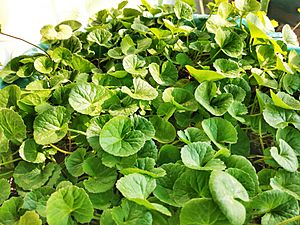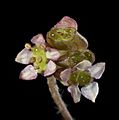Indian pennywort facts for kids
Quick facts for kids Indian pennywort |
|
|---|---|
 |
|
| Conservation status | |
| Scientific classification | |
| Genus: |
Centella
|
| Species: |
asiatica
|
| Synonyms | |
|
Hydrocotyle asiatica L. |
|
Centella asiatica, often called gotu kola, is a special green plant. It's a type of herb that lives for many years. You can find it in warm, wet places like Africa, Asia, Australia, and islands in the Pacific Ocean. People eat it as a vegetable, and it's also used in traditional medicine in some cultures.
Contents
How Does it Look?
Gotu kola likes to grow in wet, swampy areas, both in warm and tropical climates around the world. Its stems are thin and creep along the ground, connecting one plant to another. They can be green or reddish-green.
The leaves are green and round, with a smooth feel and veins that spread out like fingers. They grow on long stalks, about 2 centimeters (less than an inch) long. The roots grow straight down and are creamy white with tiny hairs.
The plant's flowers are small, either white or crimson. They grow in little round bunches close to the ground. Each flower is tiny, less than 3 millimeters (about 0.1 inches) across, and has five or six petals. The plant also produces small fruits that have a bumpy, net-like pattern. This helps tell them apart from similar plants. The whole plant, including the roots, is ready to be picked in about three months.
Where Does it Grow?
Centella asiatica is originally from places like India, Southeast Asia, and wet areas in the southeastern United States. Since it's a water plant, it can easily soak up bad stuff like pollution from the water. This means it's very important for the water it grows in to be clean.
You can also grow gotu kola in drier soil, as long as you water it regularly. This makes it a good plant for a home garden.
Cooking with Gotu Kola
Gotu kola is a popular ingredient in many dishes, especially in Asia.
In Burmese cuisine, people use raw gotu kola to make a salad. They mix it with onions, crushed peanuts, bean powder, and add lime juice and fish sauce for flavor.
In Sri Lanka, gotu kola is a very common leafy green. It's called gotu kola there. A popular dish is malluma, which is a side dish often eaten with rice and vegetarian meals like dal or pumpkin curry. It's thought to be very healthy. To make gotu kola malluma, people finely chop the plant and mix it with grated coconut, diced shallots, lime (or lemon) juice, and sea salt. Sometimes, they add chopped green chilis, chili powder, turmeric powder, or chopped carrots. The bitter fruit parts of the plant are usually removed.
Another Sri Lankan dish is a type of porridge called kola kenda. This is made with well-boiled red rice, coconut milk, and a purée of gotu kola. It's often sweetened with jaggery. Gotu kola leaves are also used in sweet drinks and herbal teas. Sometimes, the leaves are stir-fried in coconut oil or cooked in coconut milk with garlic.
In Indonesia, the leaves are used in a salad called sambai oi peuga-ga and mixed into a dish called asinan. In Cambodia, Vietnam, and Thailand, the leaves are used to make a drink or eaten raw in salads and cold rolls. In Bangkok, you can find vendors selling gotu kola drinks.
In Malay cuisine, it's known as pegaga and used in ulam, which is a type of vegetable salad. C. asiatica is also widely used in different Indian regional cuisines. In Bangladesh and West Bengal, India, it's called Thankuni Pata. A tasty snack is Thankuni Patar Bora, which is like a pakora made from mashed gotu kola, lentils, sliced onion, and green chilli.
Gotu Kola in Old Traditions
In traditional medicine, Centella asiatica has been used for a long time to help with different problems and small cuts. However, it's important to know that scientists are still studying how well it works and if it's always safe.
Sometimes, if you put it on your skin, it might cause a rash or irritation. If you eat it, it might make you feel sleepy. It's always a good idea to talk to a trusted adult or doctor before trying any plant for health reasons.
Images for kids
See also
 In Spanish: Centella asiatica para niños
In Spanish: Centella asiatica para niños







